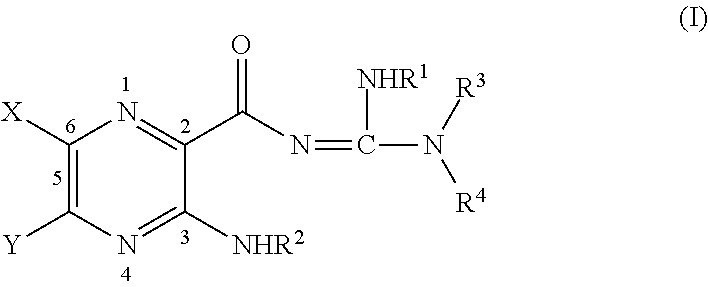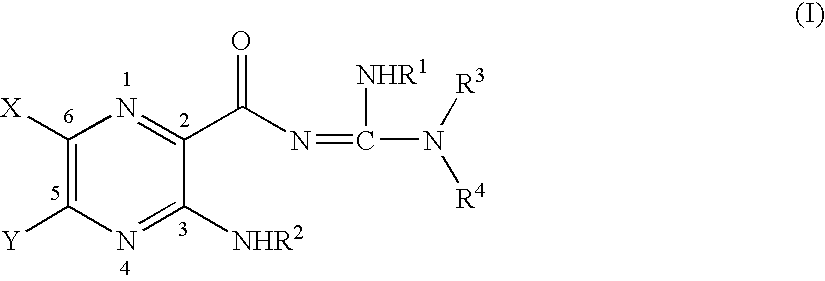Cyclic amide and ester pyrazinoylguanidine sodium channel blockers
a sodium channel blocker and pyrazinoylguanidine technology, applied in the field of cyclic amide and ester pyrazinoylguanidine sodium channel blockers, can solve the problems of inability to clear mucus from airway surfaces, inability to clear mucus reflects an imbalance between the amount of liquid, and the problem of initiating problems, so as to achieve less reversible, less reversible, and more potent
- Summary
- Abstract
- Description
- Claims
- Application Information
AI Technical Summary
Benefits of technology
Problems solved by technology
Method used
Image
Examples
example 1
Synthesis of 4-(1-{4-[N′-(3,5-diamino-6-chloropyrazine-2-carbonyl)guanidino]-butyl}piperidin-4-yl)butyramide (ALB 26797) (Scheme 1)
[0375]
ALB 26797
4-Piperidin-4-yl-butyric acid methyl ester (2)
[0376]Trimethylsilyl chloride (9.2 ml, 72.46 mmol) was added to a solution of 4-piperidin-4-yl-butyric acid (1) (5.00 g, 24.15 mmol) dissolved in anhydrous methanol (100 mL). The resulting solution was stirred at room temperature for 48 hours, and concentrated under vacuum to complete dryness to give 2 (4.50 g, 97%) as a white solid, which was used directly in the next step without further purification: 1H NMR (300 MHz, CD3OD) δ 1.20-1.46 (m, 4H), 1.52-1.74 (m, 3H), 1.96 (d, 2H), 2.35 (t, 2H), 2.96 (t, 2H), 3.36 (t, 2H), 3.68 (s, 3H); ESI MS m / z 186 [C10H19NO2+H]+.
4-{1-[4-(1,3-Dioxo-1,3,3a,7a-tetrahydroisoindol-2-yl)butyl]piperidin-4-yl}butyric acid methyl ester (3)
[0377]To a suspension of 2 (1.96 g, 8.86 mmol), K2CO3 (2.82 g, 17.72 mmol) and acetone (100 mL) was added 2-(4-iodobutyl)-3a,7a-dih...
example 2
Synthesis of 4-(4-{4-[N′-(3,5-diamino-6-chloropyrazine-2-carbonyl)guanidino]-butyl}piperazin-1-yl)butyric acid (14) (Scheme 2)
[0381]
4-[4-(1,3-Dioxo-1,3-dihydroisoindol-2-yl)butyl]piperazine-1-carboxylic acid tert-butyl ester (9)
[0382]N-(4-Bromobutyl)phthalimide 7 (9.70 g, 34.40 mmol) was added to a suspension of potassium carbonate (8.20 g, 59.30 mmol) and piperazine-1-carboxylic acid tert-butyl ester 8 (5.00 g, 26.80 mmol) in acetone (125 mL). The mixture was heated at reflux for 14 hours. After cooling to ambient temperature, the reaction mixture was filtered and the filtrate concentrated to a waxy yellow solid. Purification by column chromatography (silica gel, gradient of 70:30 to 0:100 hexanes / ethyl acetate, v / v) gave compound 9 (8.69 g, 84%) as a yellow solid: 1H NMR (300 MHz, CDCl3) δ 1.45 (s, 9H), 1.46-1.59 (m, 2H), 1.63-1.76 (m, 2H), 2.32-2.40 (m, 6H), 3.38-3.44 (m, 4H), 3.71 (t, J=6.9 Hz, 2H), 7.71-7.73 (m, 2H), 7.82-7.84 (m, 2H); ESI MS m / z 388 [C21H29N3O4+H]+.
2-(4-pipera...
example 3
Synthesis of 5-(4-{4-[N′-(3,5-diamino-6-chloropyrazine-2 carbonyl)guanidino]-butyl}piperazin-1-yl)pentanoic acid amide (22) (Scheme 3)
[0388]
4-(4-tert-Butoxycarbonylaminobutyl)piperazine-1-carboxylic acid benzyl ester (16)
[0389]A solution of (4-bromobutyl)carbamic acid tert-butyl ester (3.75 g, 90%, 13.38 mmol) in acetone (10 mL) was added to a mixture of piperazine-1-carboxylic acid benzyl ester 15 (2.68 g, 12.16 mmol), sodium iodide (1.82 g, 12.16 mmol), and potassium carbonate (5.04 g, 36.47 mmol) in acetone (100 mL). The reaction mixture was stirred at reflux for 24 h. The mixture was concentrated in vacuo, the resulting residue was diluted with dichloromethane and insoluble inorganics were filtered off. The filtrate was concentrated in vacuo and the resulting residue was purified by Biotage silica gel column chromatography using methanol / dichloromethane (gradient 0% to 5%) to give 4-(4-tert-butoxycarbonylaminobutyl)piperazine-1-carboxylic acid benzyl ester (16) as a viscous, bro...
PUM
| Property | Measurement | Unit |
|---|---|---|
| size | aaaaa | aaaaa |
| size | aaaaa | aaaaa |
| size | aaaaa | aaaaa |
Abstract
Description
Claims
Application Information
 Login to View More
Login to View More - R&D
- Intellectual Property
- Life Sciences
- Materials
- Tech Scout
- Unparalleled Data Quality
- Higher Quality Content
- 60% Fewer Hallucinations
Browse by: Latest US Patents, China's latest patents, Technical Efficacy Thesaurus, Application Domain, Technology Topic, Popular Technical Reports.
© 2025 PatSnap. All rights reserved.Legal|Privacy policy|Modern Slavery Act Transparency Statement|Sitemap|About US| Contact US: help@patsnap.com



